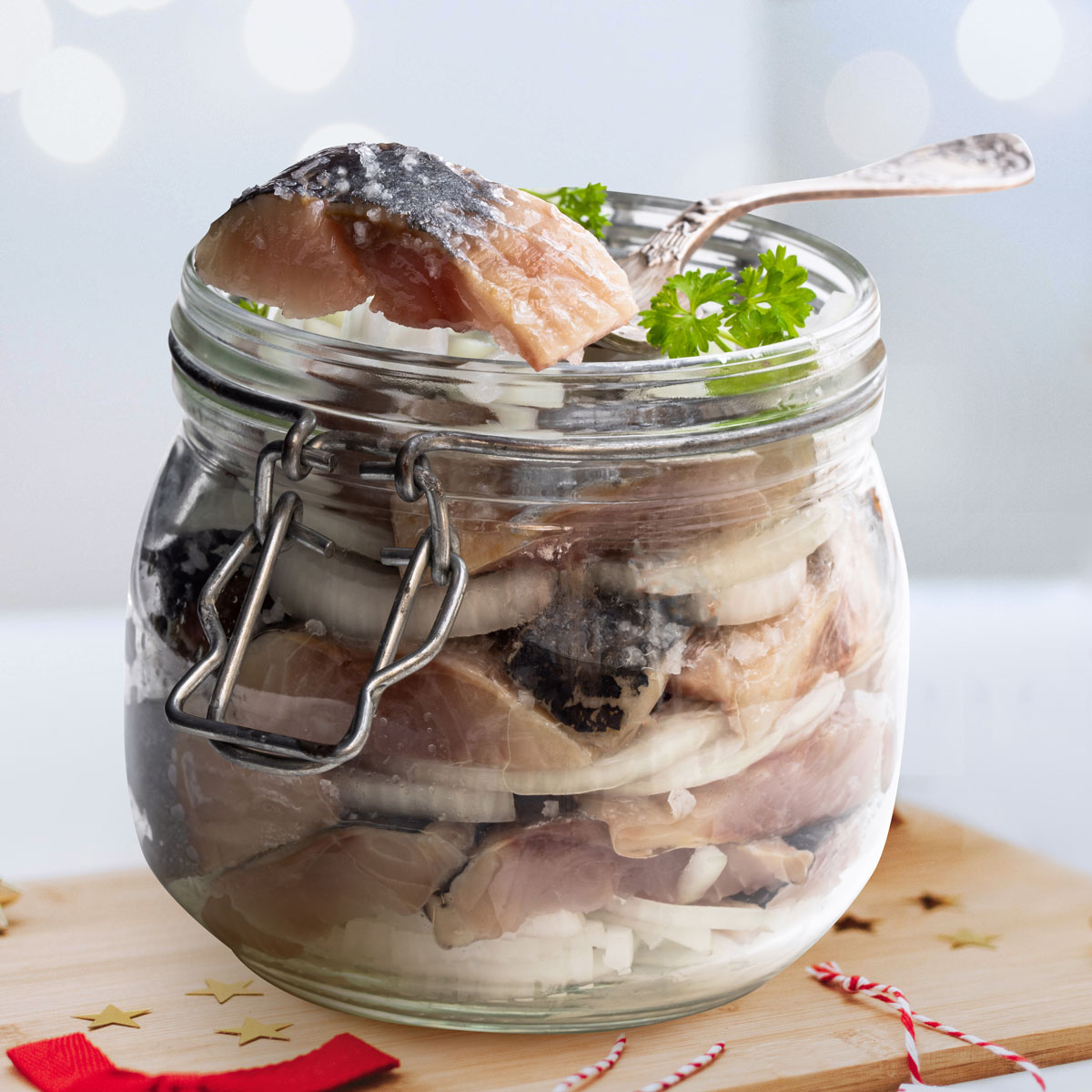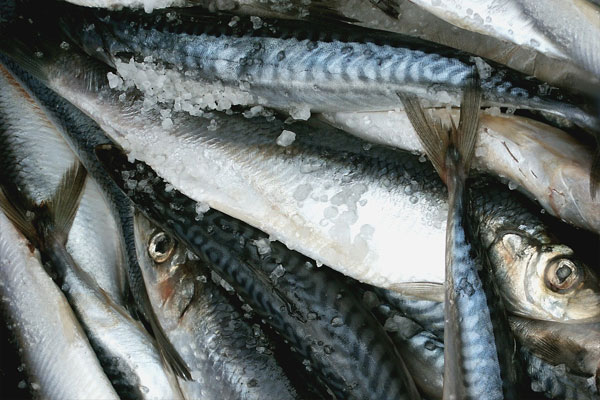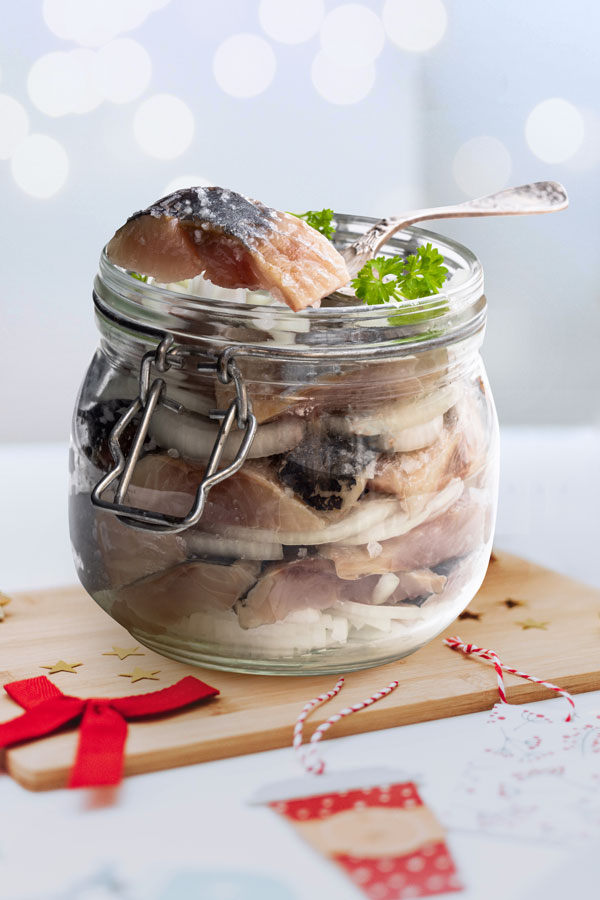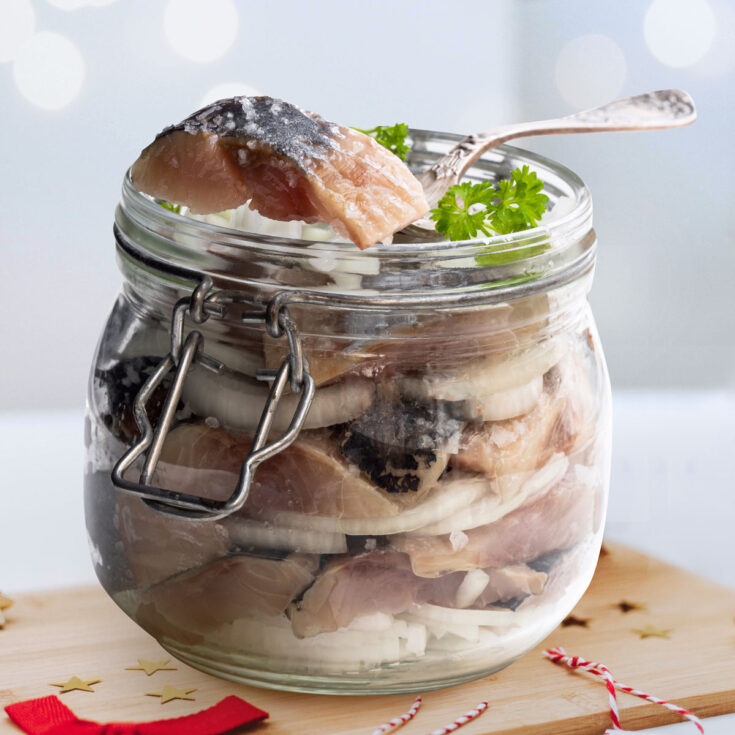Śledź w occie
Pickled Herring (in Vinegar)
How to pronounce it?
shletsh vots-chair / shletsh vots-chie
‘Play’ to hear:

Traditionally, herring is preserved by either curing in brine or by pickling in vinegar. In this recipe, we’ll do the latter; together with some onions and spices. Once you’ve pickled it, use it in your favourite recipe or simply serve it on a piece of dark rye bread. Delightful.
In Europe (and parts of Asia), we’re obsessed with herring in all forms – yet somehow that trend never caught on across the pond. So if you’ve never tried it, don’t miss out!
For the full list of ingredients & detailed instructions, please see the recipe card at the end of this post. But before you scroll, there’s important stuff to know below.
In Poland, a Christmas Eve dinner wouldn’t be complete without ‘Śledź’.
Herring fillets (pickled in vinegar, oil or sour cream) are traditionally served as a cold appetizer or a side dish. If you’re looking for more Polish festive recipes, try these:
Do you need any special ingredients to make this Herring pickled in vinegar?
Yes, you’ll need one of the following:
- salted herring fillets (in brine), or
- fresh herring fillets – you can buy a whole fish of course, but then you’ll have to gut and debone it.
Herring was once abundant, but in the last few decades, herring stocks have declined dramatically. Baltic herring is small and lean. Atlantic herring is incomparably larger and has more meat in it than the Baltic herring. This is mainly due to better living conditions for fish compared to our Baltic Sea – less pollution and lower water temperature.

A true king of herrings lives here – in the North Sea, just by Denmark and Norway. It’s a young, immature herring known as ‘Matjes’ (more about it here on Wikipedia). Matjes is much plumper, richer in fat and milder in taste. Not surprisingly, it’s also expensive.
Pacific herring stocks are severely depleted. Whatever’s left, gets exported – mainly to Japan, where it’s considered a delicacy.
🇵🇱 Herring was a staple of the Polish diet for centuries. But today high-quality fish is hard to come by. When it comes to prepackaged mass-market herrings (sold in plastic wraps and buckets), the list of ingredients is often dodgy, to say the least. It’s full of unnecessary additives, phosphates, and citrates… where all we need is fish and salt.
You’ll also stumble upon herring fillets sold as ‘a la matjas’. It’s a marketing ploy, they’re just regular herrings.
I would recommend making a purchase at specialized fishmongers or splashing out on real ‘Matjes’ (available in Makro and Kuchnie Świata stores).
🌍 Internationally, if you live in the Netherlands, Germany or Scandinavia – you’re in luck, I’m sure you know all the good spots to buy a decent herring.
Elsewhere in the world, your best bet is to head to Dutch, Polish, Jewish, Scandinavian, German or Russian groceries. There are more and more online fishmongers popping up, so it’s worth having a quick Google search in your region.
What should you serve with this Pickled Herring?
Pickled Herring is often enjoyed as a snack or an aperitif. It goes especially well with dark rye bread and some dill pickles on the side.
Boiled eggs and potatoes in various forms are also common companions. Herring marinated in vinegar makes a fine salad and sandwich ingredient.
In terms of beverages, this classic herring pairs well with a shot of vodka (especially Polish vodka!).
Herring is present on a Polish Christmas Eve table (‘Wigilia’) and is served alongside other dishes.
Can you Pickle this Herring another way?
In general, there are two ways of pickling fresh herrings: in a vinegar-based marinade (as in our recipe here), or in brine.
This recipe is a great basis for countless flavour combinations. Here are some suggestions you can try adding to your marinade:
- Herbs and spices: bay leaves, rosemary, dill, mustard seeds, allspice berries, juniper berries, peppercorns of every colour, cinnamon, cloves, curry powder, paprika, chilli peppers, sandalwood, honey
- Veggies, roots and fruit: onions, ginger, garlic, carrots, raisins, wild mushrooms, dried tomatoes, horseradish
- Condiments and liquids: mustard, sherry
What diets is this Pickled Herring suitable for?
These Pickled Herrings are suitable for pescatarians. They’re also dairy-free.
How long can you keep this Pickled Herring in the fridge?
Once served, these Pickled Herrings can safely stay on the table for a few hours.
Store them in the fridge (on the lower shelf) for up to 2-3 weeks, ideally in a jar or another type of glass container with a lid.
Can I freeze this Pickled Herring?
No, once it’s pickled, you shouldn’t freeze it. But this Pickled Herring lasts a really long time in a refrigerator, there’s no need to freeze it.

Pickled Herring Marinated in Vinegar

Pickled Herring is just a herring that has been marinated in a mixture of mostly vinegar, with a little sugar, onions and some additional flavours and spices. Easy to make, easy to eat :)
Ingredients
- 2.2 lb (1 kg) herring fillets, fresh or salted in brine
For vinegar marinade
- 3 cups (700 ml) water
- 5 tbsp sugar
- 2 tbsp salt
- 4 bay leaves
- 5 allspice berries
- 1 tsp white/yellow mustard seeds
- 1 tsp black peppercorns
- 1-2 small onions (4 oz, 115g each), yellow or red
- 1⅓ cups (10 fl oz, 300ml) white vinegar (10% acidity)
- 1 small carrot (optional; under 2 oz, 50 g)
Instructions
When using Salted Herring:
- Place salted herring fillets into a large bowl.
- Pour cold water or milk over the fish. The water should cover the fish completely.
- Cover the bowl with cling film and let the herring soak overnight in the fridge. If by any chance you tend to wake up in the middle of the night, it’s a good idea to swap the water for a fresh one.
- The next day, drain the salty water off.
- Have a taste - it shouldn’t be overly salty anymore. Pickle as per ‘fresh herring’ instructions below.
When using Fresh Herring:
- If you’ve purchased a whole fish, here’s a guide on how to break it down by Saveur. Don’t worry about the smaller bones because they would either soften or even dissolve completely in the marinade.
- Peel onions, slice them thinly into rings. Peel the carrot, slice it into rounds.
- Pour three cups of water into a cooking pot, add 5 tablespoons of sugar, 2 tablespoons of salt and all the spices. Bring to boil, then reduce the heat to ‘low’. Cook for 4 to 5 minutes, allowing the spices to release their flavours.
- Take the marinade off the heat. Drop raw onions in, and allow the whole thing to cool down.
- When the marinade has cooled, add in the vinegar and stir.
- Now we’ll be packing our herrings into jars. One large jar or a few smaller jars - the size is up to you. I prefer smaller jars, they fit better in my fridge.
- Arrange herring fillets in the jar - quite tightly - with pieces of onion and carrot in between the layers. Pour in the marinade, making sure that everything is covered completely.
- Seal the jar(s) and store in the fridge for a few days.
- Pickled herrings are ready to eat after 3 to 5 days.
Notes
You'll need some jars - either one big jar or a few smaller ones. Choose a size that will fit into your fridge.
Nutrition Information:
Yield:
10Serving Size:
1Amount Per Serving: Calories: 42Total Fat: 0gSaturated Fat: 0gTrans Fat: 0gUnsaturated Fat: 0gCholesterol: 0mgSodium: 1405mgCarbohydrates: 10gFiber: 1gSugar: 8gProtein: 0g
Polonist is reader-supported. When you buy through links on our site, we may earn a small affiliate commission. Learn more
Recipe Information
Filed under:
Alternative traditional/regional names:
Śledź marynowany w zalewie octowej, Śledzik
Also known / Misspelt internationally as:
Tested by:
First published on:
Recipe by / Adapted from:
Story by:
Bibliography / References: